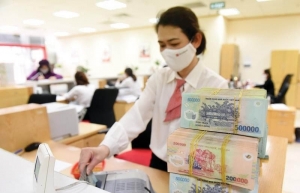Rate reductions deemed well-timed
The State Bank of Vietnam (SBV) last week announced additional adjustments to a series of key interest rates, effective from May 25. This move marks the third round of interest rate decreases within a span of less than three months, signifying its resolute efforts in lowering the interest rate landscape, aimed at providing vital support to businesses and stimulating overall economic growth.
 |
| The SBV’s rate reduction moves cater specifically to existing customers, Photo: Le Toan |
The recent decision to lower interest rates has garnered praise from industry experts and leaders who believe it to be an appropriate and well-timed move.
Le Quang Vinh, deputy CEO of Vietcombank, deemed it a sound decision that is well-aligned with the current economic landscape. “Looking ahead, we anticipate that lending rates will correspondingly decrease as deposit interest rates uniformly decline,” Vinh said.
Pham Nhu Anh, CEO of MB, recognises the difficulties faced by the market in absorbing capital and the prevailing economic challenges but added that the reduction will alleviate many challenges for customers and banks in the near future.
“In response, MB is poised to introduce new policies aimed at supporting customers during this period. We have witnessed a credit growth of approximately 6.5 per cent since the beginning of the year. With the new, lower interest rate framework, we are optimistic that credit growth will be even stronger in the remaining months, projecting a growth rate of 9 per cent by the end of June,” he said.
Nguyen Dinh Tung, CEO of OCB, disclosed that the SBV set forth stringent requirements for reducing lending rates. He noted that the rate reduction pertains specifically to existing customers, rather than new ones. Notably, current lending practices by various banks already offer substantially lower interest rates to new customers.
Director of Institutional Customer Securities Services at SSI Securities, Nguyen Anh Duc, also noted that the rate cut helps lower capital costs for businesses, thereby improving their profitability.
“Increased consumer demand and overall economic improvement also enhance the prospects and valuations of companies. Additionally, the influx of capital into the market and improved investor sentiment are notable benefits,” he said.
Portfolio manager and board member of Finnish fund PYN Elite, Petri Deryung, anticipates an upswing in Vietnam’s GDP growth for the remainder of 2023. “This optimistic outlook is driven by the prevailing trend of declining interest rates, which is expected to stimulate economic expansion,” he said.
According to Deryung, the Vietnamese market presently offers enticing stock prices, making it an attractive prospect for investors. However, the key concern lies in determining when improved liquidity conditions and the reduced interest rates will effectively lure back a significant influx of investors.
Mirae Asset Securities, on the other hand, evaluates that the recent interest rate cut will place a favourable impact on industries burdened with high levels of short-term and long-term debt. Based on data from 2022, the real estate, steel, food, aquaculture, and construction sectors, all of which presently bear significant debt burdens, are primed to reap immediate benefits from the strategic manoeuvre orchestrated by the SBV, Mirae added.
Credit institutions are not obligated to enforce loan repayments when they fall due, while still ensuring the repayment of deposits. Consequently, this initiative diminishes loan volumes and slows down capital circulation within the economy.
Additionally, the banking system is presently undergoing restructuring and grappling with the resolution of non-performing loans, in addition to upgrading governance standards in alignment with international practices. Experts also raise their concerns that some smaller-scale commercial banks are maintaining elevated deposit rates to retain customers, thereby intensifying the challenge of reducing lending rates.
| Nguyen Dinh Tung - CEO, OCB While there has been a cooling trend recently, the decline in lending rates has not corresponded proportionally with the decrease in deposit rates. This imbalance stems from the lag between deposit rates and lending rates, as the current lending rates are influenced by the cost of past deposits. Consequently, the funds currently being disbursed by banks were sourced at higher interest rates towards the end of 2022 and the beginning of Q1/2023. Thus, banks are still bound by obligation to pay these elevated rates for the borrowed funds, making a reduction in lending rates impractical. Some banks had offered deposits with interest rates as high as 10-11 per cent per year for 12-month fixed deposits towards the end of 2022. These banks will continue to honour these rates for a few more months until the maturity date. There remains a substantial inventory with a high-cost basis. A sudden reduction in lending rates would significantly impact the business performance of banks. |
 | Bank lending interest rates will be cut at appropriate time: SBV chief Reducing interest rates, maintaining interest subsidies, hiking credit limits, and providing unsecured loans to manufacturing businesses are among the demands made by businesses in the south-eastern region to the State Bank of Vietnam (SBV). |
 | State Bank of Vietnam implements third round of interest rate cuts to boost economy The State Bank of Vietnam (SBV) has just announced a series of interest rate reductions. This marks the third time it has decided to lower operating interest rates since the beginning of 2023, with the new changes taking effect from May 25. |
 | Falling interest rates likely in H2 On May 23, the SBV announced additional adjustments to a series of key interest rates, effective from May 25. This move marks the third round of reductions designed to boost the economy in less than three months. Interest rates are predicted to soften in the second half of the year, due to several factors in both the domestic and international markets. |
What the stars mean:
★ Poor ★ ★ Promising ★★★ Good ★★★★ Very good ★★★★★ Exceptional
Related Contents
Latest News
More News
- Tax sector wraps up 2025 and sets priorities for next year (December 25, 2025 | 14:00)
- A tipping point for digital and hybrid wealth management in Vietnam (December 23, 2025 | 13:33)
- $250 million deal targets women-owned SMEs, sustainable agriculture (December 22, 2025 | 17:40)
- Stock market posts resilient 2025 performance (December 19, 2025 | 18:17)
- Citi Vietnam receives 2025 AmCham CSR recognition (December 19, 2025 | 16:35)
- As global green supply chain reshapes, will Vietnam be left behind? (December 19, 2025 | 08:00)
- Banks gear up for massive capital increases (December 18, 2025 | 17:04)
- Securing capital and efficiency for Vietnam’s 2026-2030 growth ambitions (December 17, 2025 | 10:00)
- Energy sector in need of blended finance mechanisms (December 17, 2025 | 09:00)
- Vietnam still has room to mobilise capital for sustainable growth (December 17, 2025 | 08:57)

 Tag:
Tag:





















 Mobile Version
Mobile Version